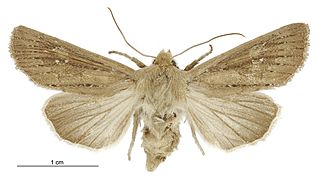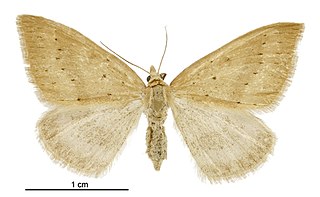Flexiptera is a monotypic moth genus in the family Gelechiidae erected by Anthonie Johannes Theodorus Janse in 1958. Its only species, Flexiptera revoluta, was first described by Edward Meyrick in 1918. It is found in South Africa.
Frisilia is a genus of moths in the family Lecithoceridae. The genus was erected by Francis Walker in 1864.

Ichneutica phaula is a moth of the family Noctuidae. It is endemic to New Zealand. It is found only in the South Island in the Nelson district, the eastern side of the South Island and Stewart Island. I. phaula inhabits tussock grasslands and coastal sand dunes. Host species include Ficinia spiralis, Ammophila arenaria, Poa cita and other "tussock grasses". The adults of this species are on the wing from October to December and are attracted to sugar traps. I. phaula is similar in appearance to both I. micastra, with whom it does not share a range, and I. sapiens which differs from I. phaula as I. sapiens is darker and has a more reddish tinge.
Hypatima lactifera is a moth in the family Gelechiidae. It was described by Edward Meyrick in 1913. It is found in Assam, India.
Pessograptis thalamias is a moth in the family Gelechiidae. It was described by Edward Meyrick in 1923. It is found in Amazonas, Brazil.
Athrips neograpta is a moth of the family Gelechiidae first described by Edward Meyrick in 1914. It is found in Namibia and South Africa.
Scrobipalpa chersophila is a moth in the family Gelechiidae. It was described by Edward Meyrick in 1909. It is found in South Africa.
Idiophantis paraptila is a moth of the family Gelechiidae. It was described by Edward Meyrick in 1916. It is found in Sri Lanka.
Aristotelia paterata is a moth of the family Gelechiidae. It was described by Edward Meyrick in 1914. It is found in Guyana and Peru.
Frisilia compsostoma is a moth in the family Lecithoceridae. It was described by Edward Meyrick in 1921. It is found in the Democratic Republic of the Congo's former Katanga Province and in Zimbabwe.
Frisilia melanardis is a moth in the family Lecithoceridae. It was described by Edward Meyrick in 1910. It is found on Borneo.
Frisilia senilis is a moth in the family Lecithoceridae. It was described by Edward Meyrick in 1910. It is found in southern India.
Frisilia strepsiptila is a moth in the family Lecithoceridae. It was described by Edward Meyrick in 1910. It is found in southern India.
Frisilia sulcata is a moth in the family Lecithoceridae. It was described by Edward Meyrick in 1910. It is found in Nepal and Assam, India.
Frisilia verticosa is a moth in the family Lecithoceridae. It was described by Edward Meyrick in 1914. It is found in southern India.
Frisilia dipsia is a moth in the family Lecithoceridae. It was described by Edward Meyrick in 1910. It is found in Sri Lanka.
Frisilia notifica is a moth in the family Lecithoceridae. It was described by Edward Meyrick in 1910. It is found in Sri Lanka.
Frisilia homochlora is a moth in the family Lecithoceridae. It was described by Edward Meyrick in 1910. It is found in southern India and Jiangxi, China.
Moca mitrodeta is a moth in the family Immidae. It was described by Edward Meyrick in 1922. It is found in Peru.

Asaphodes mnesichola is a species of moth in the family Geometridae. It is endemic to New Zealand and has been observed in the South Island. This species inhabits subalpine native scrub. Adults of this species are on the wing in January and February.

